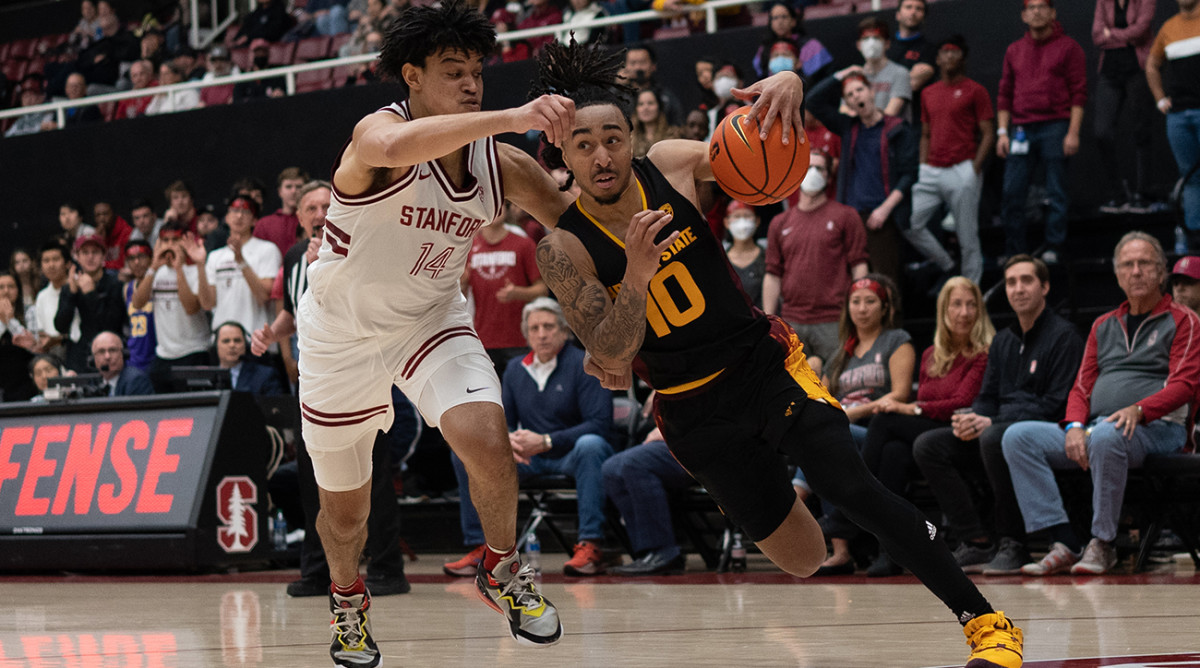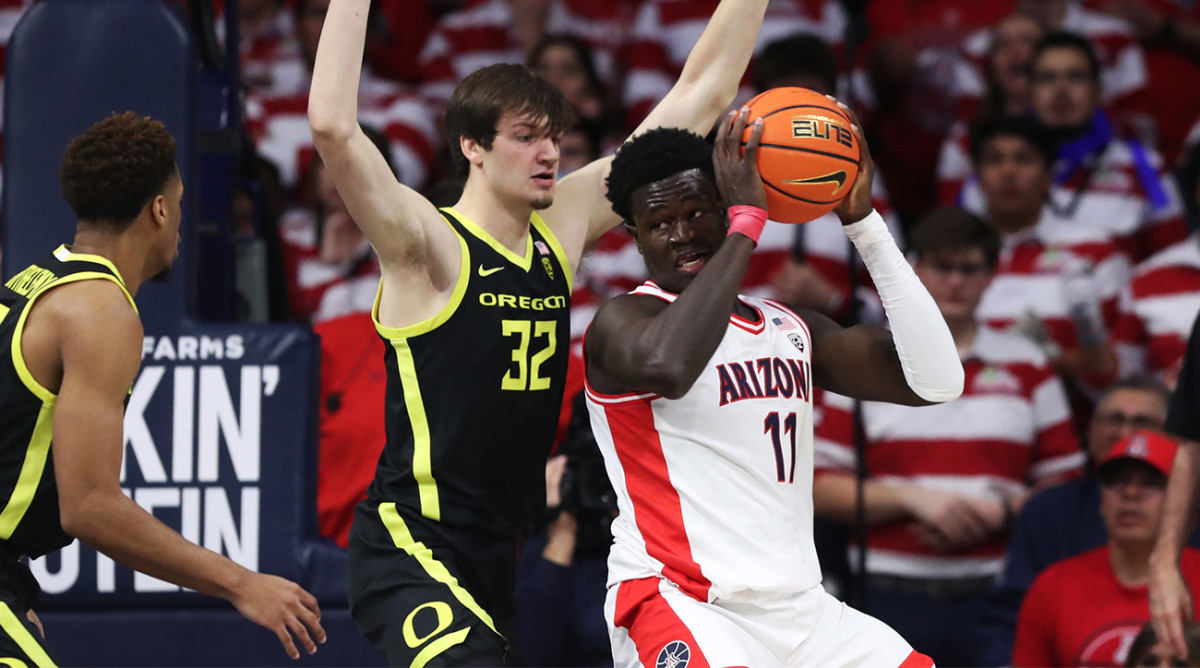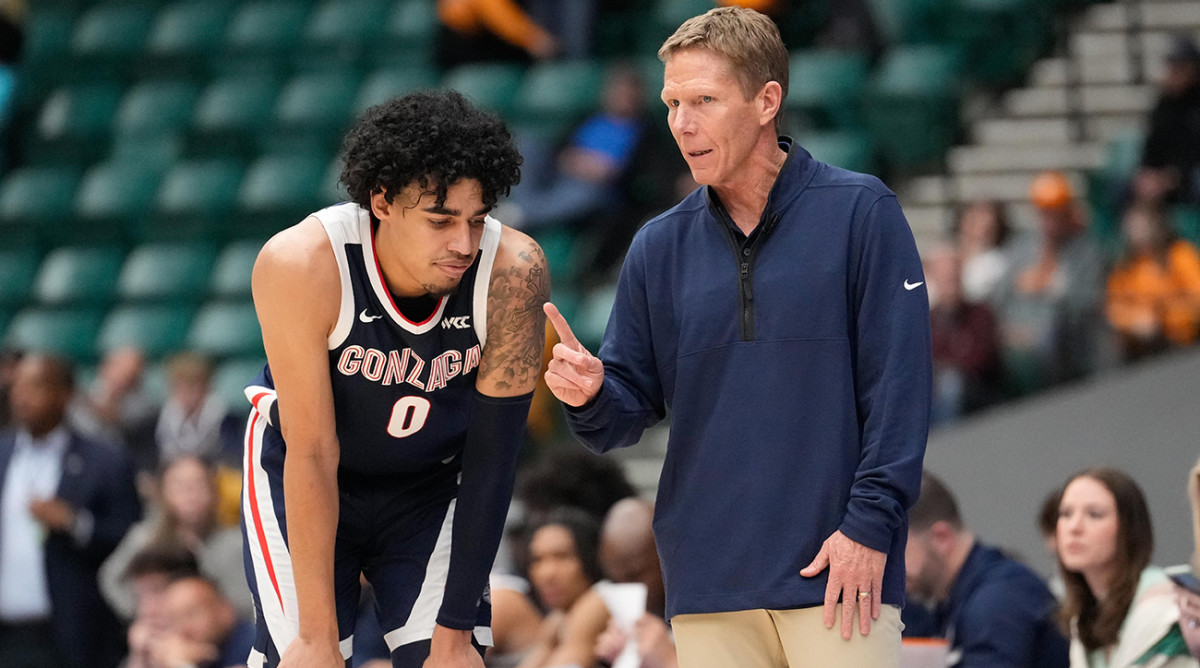The Pac-12 Appears Dead, and the College Hoops Implications Are Massive

Last week’s landscape-altering conference-realignment moves have left a Power 5 league staggering and seen some of college athletics’ biggest brands switch conference affiliations. The Big 12 started this round of realignment with its move to swipe Colorado from the Pac-12, and the Big Ten went in for the kill with Oregon and Washington.
In general, these moves are made entirely based on football. It’s why Stanford, the nation’s best athletic department 26 out of the last 29 years, is left in flux as things stand today. The money involved in the highest levels of college football has made even the cash from the men’s NCAA tournament look like a drop in the bucket. That means major shifts to the college basketball world happen with little mind paid to the sport itself. Here’s where things stand now for each of the most-impacted leagues and the big questions that still need answering.

Pac-12 Holdovers and Mountain West
The four schools left behind in the Pac-12 have been largely inconsequential in the grand scheme of college basketball over the last decade. Stanford’s last trip to the men’s NCAA tournament was in 2014. Cal danced last in 2016 and has had five 20-loss seasons since. Oregon State, outside of a miracle run to the Elite Eight in ’21, has been mostly irrelevant for decades. And Washington State, arguably the hardest Power 5 job thanks to its location and lack of history, is 15 years removed from its last trip to March Madness. These four schools have generally been overmatched even in a conference that has struggled on the national stage, producing more than four NCAA tournament bids just once in the last six tournaments. From a purely basketball standpoint, a Pac-12 that was already going to be without UCLA and USC profiled as a fairly weak basketball conference, so the scattering of its remaining teams isn’t hugely detrimental for men’s basketball on a macro level.
That said, these four schools’ being left behind has already had impacts on the day-to-day of their programs. Washington State lost a rare top-150 commitment in 2024 point guard Adam Njie due to the “uncertainty of the Pac-12.” Other programs are lining up recruiting visits for the fall with prospects and are being asked questions they “don’t have answers to yet,” per one staff member at a holdover school. These moves could also impact the coaching carousel: Belt-tightening due to reduced TV revenue could buy Wayne Tinkle some time at Oregon State, and uncertainty about the program’s future could discourage Stanford from moving on from embattled head coach Jerod Haase next spring.
The instability of the Pac-12 could benefit the Mountain West, which has earned four NCAA tournament bids in consecutive years and sent San Diego State to the national title game in 2023. If nothing else, it increases the league’s chances of holding onto the Aztecs, a widely rumored expansion target for the Pac-12 before last week’s events. A straight merger between the two leagues would make for an entertaining league out west, albeit one whose floor from an NCAA tournament-bids standpoint could be as low as one to two in down years. If the Pac-12 instead attempts to respawn with new schools, it will likely be poaching largely from the Mountain West, which could leave some in that league in a similar spot to where the four Pac-12 holdovers sit now.

Big 12
The Big 12 has been KenPom’s highest-rated conference in eight of the last 10 years. It hasn’t even been close lately: The gap between the Big 12 and second place was wider than the gap between second and fifth in 2022 and nearly that wide again in ’23, per KenPom’s adjusted efficiency marks. The league’s future officially being secure is good news for the college basketball world.
The addition of Arizona will garner the most attention from a basketball standpoint, and there’s no doubt it’s a boon for the league. Arizona is arguably a top-10 program in the sport, and this marriage seems like a win for both parties. With annual matchups against the likes of Kansas, Houston and Baylor, the Wildcats will play far more marquee conference games than they would have in a Pac-12 without UCLA, and the Big 12 expands its basketball reach with one of the sport’s premier brands out west.
Outside of Arizona though, I think there’s a fairly strong case to be made that the Big 12’s last two rounds of realignment will actually weaken the league in basketball. Seven of the eight “holdover” Big 12 schools have a higher average KenPom finish over the last decade than Arizona State, Utah and Colorado. And of the league’s eight total new additions since Texas and Oklahoma started this realignment wave two years ago, six rank in the bottom half of the new Big 12 in average finish over the last decade. The Big 12’s analytical dominance of the sport has been driven at least partially by the bottom of the league’s strength, with no team finishing outside the top 70 of KenPom in either 2022 or ’23. That figures to change in a more bloated 16-team league.
The new Big 12’s 10-year KenPom averages. Arizona the big add in this cycle… other three profile as among the league’s worst. Houston’s rank tanked by ugly 2014 + 2015, but recent history is much better: https://t.co/ZZgT4o8HVk pic.twitter.com/b7SpgkAYNj
— Kevin Sweeney (@CBB_Central) August 5, 2023
That may not be a bad thing. None of these new Big 12 programs, with the exception of perhaps UCF, profiles as a perennial cellar-dweller, and even the Knights at least have upside with a burgeoning football program based in a strong location. Having more winnable games while still having elite brands at the top of the conference isn’t a bad thing for the league. It’s probably harder today than it was two weeks ago for the “four corners” Pac-12 defectors outside of Arizona to make the NCAA tournament, but those programs should receive some recruiting momentum from their moves. The only real downside is the likelihood of fewer home-and-home matchups in the league thanks to its larger size: I’ll miss the Big 12’s double round-robin schedule.
All told, it’s hard to describe these moves as anything but a win for the Big 12. The addition of another blue-chip brand in Arizona outweighs any potential dilution from the other three less-elite hoops schools. The Big 12 will remain a force atop the sport.
Big Ten
The Big Ten’s western flank now features four schools with the additions of Oregon and Washington. From a league-strength standpoint, the impact feels marginal. Oregon is a strong program (albeit one that has slipped a bit in the last few seasons) with the ability to consistently recruit elite-level prospects, while Washington fits right in toward the middle of the league. It’s hard to envision the addition of these two having a major impact on how the Big Ten is perceived nationally, though: Neither seem overly likely to help the league get closer to ending its national title drought, nor will either serve as an anchor at the bottom of the league. It’s also likely that the recruiting impact of adding the two schools will be minimal: Perhaps another Big Ten school can more confidently go into Seattle and recruit, but the West Coast was already unlocked somewhat by the UCLA and USC additions, and recruiting has become more nationalized as is.
From a logistical standpoint, however, the impact could be drastic. Big Ten coaches are well known for bellyaching about long trips home when bouncing between, say, Maryland and Minnesota. Imagine how they’ll feel about a trip from Piscataway, N.J., to Eugene, Ore. A scheduling model hasn’t been decided upon yet, but it seems likely that adding two more schools out west means every Big Ten team will make a trip to the West Coast at least once per season. That’s plenty of extra wear and tear for a league already known for how grueling its 20-game conference schedule is.
The question many around the league are now pondering is whether expansion to 18 teams will make an even longer conference schedule an inevitability. It’s something that has been on the minds of Big Ten coaches since the additions of UCLA and USC. A 22- or 24-game league schedule would allow for more home-and-home matchups throughout the season. But would it produce more TV revenue for the league? If ESPN wasn’t willing to pay up for an extra SEC football game on the calendar, why would Fox and NBC pay for added college basketball inventory … especially since that inventory would likely be during December football season? And if it wouldn’t net much additional revenue, will playing more high-intensity league games really benefit its teams come March?

Three Looming Questions
What’s next for college hoops powers UConn and Gonzaga?
The two college hoops powerhouses had been floated as potential Big 12 additions due to commissioner Brett Yormark’s affinity for basketball. Given how rapidly things have changed lately, it’s hard to rule anything out, but the four new additions to the league would seem to make that marriage less likely. Gonzaga could look to take advantage of changes out west and flee the West Coast Conference, but that seems unlikely to produce the financial windfall a spot in a true power conference would. UConn basketball’s best home remains the Big East, but finding a home for football could make things interesting. And a true wild card: Could the Big East pursue Gonzaga in earnest, with an eye on solidifying its basketball-focused league, given that national conferences are now all the rage?
Could this spur NCAA tournament expansion?
Starting in 2024, the SEC, Big Ten and Big 12 will have 16 or more teams each, and the ACC will have 15 of its own. (Notre Dame is a full member in basketball.) Consolidation from a Power 5 to what would functionally be a Power 4 might serve as an impetus for changes to the Big Dance, which have been discussed at the NCAA level as recently as last month. The argument: If some form of “superconferences” are assembling, shouldn’t larger percentages of teams in those leagues have a path to March? Expanding the men’s field from 68 is relatively popular among coaches, and multiple high-profile administrators have spoken in support of it. If substantial expansion happens, get ready for the 11th-place team in the SEC and 13th-place finisher in the Big Ten to be in the field … potentially devaluing the sport’s regular season.
How will women’s basketball be impacted?
The Pac-12 has struggled on the men’s side but has been among the sport’s strongest women’s hoops conferences. The league had six of its 12 teams ranked in the final AP poll last season. A perennial powerhouse program like Stanford potentially being on the outs from a conference affiliation would be a shame, but all four holdovers have had strong women’s teams in recent years. This won’t be a unique story given Stanford’s and Cal’s strength in nonrevenue sports, but women’s basketball is a burgeoning business opportunity for the NCAA and its schools, and losing a strong conference out west could hinder that.
